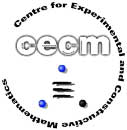 Knot Theory with KnotPlot
Knot Theory with KnotPlot Knot Theory with KnotPlot
Knot Theory with KnotPlot| Title: | Upper Bounds for Equilateral Stick Numbers | ||||||||||||||||||||||||||||||||||||||||||||||||||||||||
| Authors: | Eric J. Rawdon and Robert G. Scharein | ||||||||||||||||||||||||||||||||||||||||||||||||||||||||
| Abstract: | We use algorithms in the software KnotPlot to compute upper bounds for the equilateral stick numbers of all prime knots through 10 crossings, i.e. the least number of equal length line segments it takes to construct a conformation of each knot type. We find seven knots for which we cannot construct an equilateral conformation with the same number of edges as a minimal non-equilateral conformation, notably the 819 knot. | ||||||||||||||||||||||||||||||||||||||||||||||||||||||||
| Preprint: | PDF (418 kBytes),Gzipped PostScript (293 kBytes) | ||||||||||||||||||||||||||||||||||||||||||||||||||||||||
| Appeared in: | Contemporary Mathematics, Volume 304, 2002, pp55-75 | ||||||||||||||||||||||||||||||||||||||||||||||||||||||||
| Data: | Gzipped TAR
file of the data as it appears in the paper (integer coordinates). Double precision coordinates are available as part of the KnotPlot distribution (in the sub-directories special/ms (non-equilateral) and special/mseq (equilateral) under the KnotPlot home. If you're just interested in the stick numbers themselves, consult the table of stick numbers of minimal stick knots. Individual knots may be browsed online using the Knot Server or from the table of stick numbers. |
||||||||||||||||||||||||||||||||||||||||||||||||||||||||
| 3D view: | Try clicking on one of
the links in the table below to examine the exceptional knots in a 3D model
viewer (requires Java). Use the links in the second and third columns to
examine one knot at a time. Use the last column to view the two versions
of the knot side by side in the same window.
All the rest of the knots we found have a stick number equal to the equilateral stick number. Interactive 3D models for all of these can be accessed via the Knot Server link above, and for a select few from the table below.
|
| CoLab | My home page | KnotPlot Research Site | Knot theory |